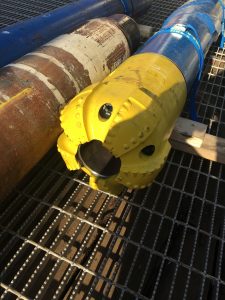“Everyone has a plan ‘till they get punched in the mouth.”
-Mike Tyson
This past week, we got punched in the mouth. Heading into this expedition, I had expectations somewhere between optimistic and unrealistic. We came out here with the ability to bring back 20 pressure cores. Somewhere along the way I convinced myself that returning with 20 pressure cores was a foregone conclusion. Not so much…

We entered our first hole with optimism, but after the first three cores, we were entirely deflated. While we did recover core, the tool was not holding pressure, meaning all the hydrate was gone—disassociated—by the time it reached the rig floor. We planned to hold off on taking the fourth core until we could run a function test in the water column, but there was a miscommunication and a fourth pressure core was taken instead. And wouldn’t you know it…our first successful pressure core! Core 4 came to the surface under pressure and with a meter and a half of hydrate-bearing sediment. This victory was like a shot of adrenaline to our team and we barreled into core 5 with renewed optimism. Alas, the optimism was not to last. The next four cores were all unable to hold pressure.
At this point, we did what I make my five and six-year-old do whenever we cross the street. We—the UT Science Party, Geotek, and the tool operator—stopped, looked, and listened. We decided to terminate this borehole early. This approximately 30 hour process to log and cement the borehole was a much needed 30 hours that allowed us to stop, and take stock of the eight tests, digging deeper into the data, looking for evidence that might elucidate the source of the tool’s problems. We took this time to look over the tool. We studied images of the tool that we’d taken as it came out of the hole. We looked at the sediment that was embedded in some of the tool’s moving parts. We looked at the engineering drawings, inspecting closely the recent changes, trying to identify some source of our consternation that we may have missed. And most importantly, we listened. 30 hours of conversations, of data discussions, lunchtime chats, hallway ideas—you name it.
In the end, we came up with a series of tests to run under a specific set of conditions to help us better understand the potential source of the problem and to see if the tool was ready to try again. That was Tuesday. Today is Thursday, and we just brought up a beautiful 2.2 m core, the first coring attempt in the new hole.
Now we march forward. I’m optimistic. Not the blind optimism I had when we took our first core, but an optimism rooted in the experience of both success and failure, and the belief that maybe, just maybe, we’ve learned something.
As the team contemplated how to move forward, they spent a lot of time enjoying the beauty surrounding them. (Video courtesy of Peter Polito)
